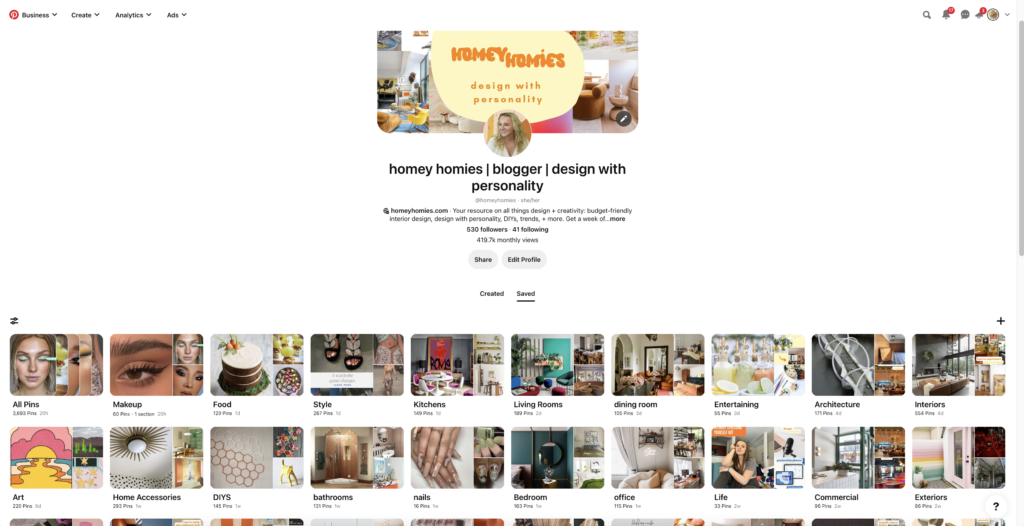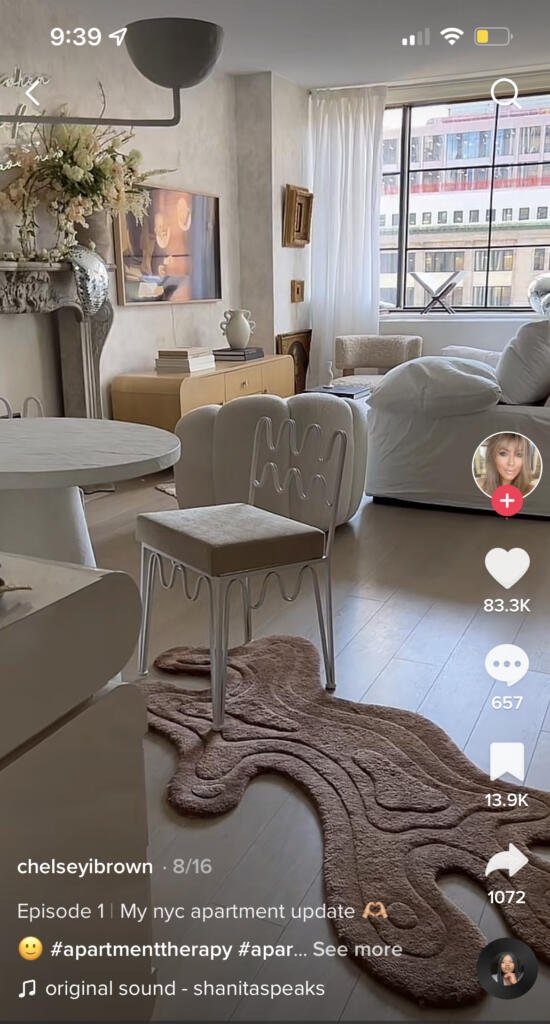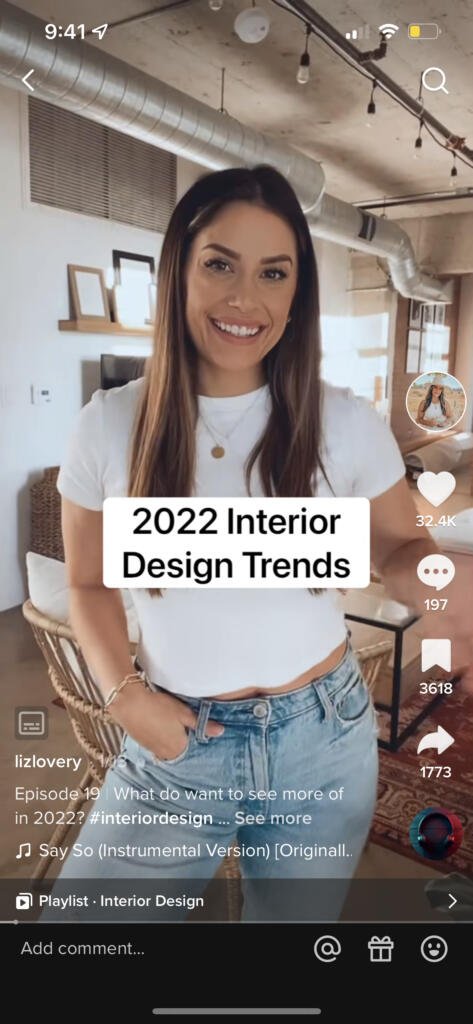If you have an interest in interior design, you’re likely always seeing something about the latest trends. Whether it’s on tiktok, on blogs (like this one) or in magazines, interior design trends are a hot topic. And you may feel compelled to incorporate these trends into your own home. But before you jump head-first into giving your home a trendy makeover, let’s first dig a little deeper into:
- what makes a trend
- how the trend cycle works
- who decides trends
- how to find a balance between trends and your own personal style.
Consider this your full guide to interior design trends and how to put them into action.
How the trend cycle works
To understand interior design trends, you first need some insight into how the trend cycle works.
While there are definitely distinctions between interior design trends vs. fashion trends vs. architectural trends, etc., they all feed off of each other. What’s popular in one design discipline often has some impact on the other disciplines. And this is both because of the actual interaction between all of these creative fields, as well as the fact that all trends to some extent are drawn from the context of the world around them.
Things like changing political situations, climate/environmental concerns, pop culture interests, and more can all have a massive impact on the trends that can be popular. Whether it’s direct or more subtle.
Trend timing
At the beginning of every year, you’ll likely see trend roundups. Posts like “the top interior design trends of 2023” should be popping up everywhere in the coming months. And this is because many trends have typically run on a yearly schedule. There may be some slight fluctuations throughout the year, but trend forecasters tend to group trends by year.
However, just because something goes out of style now, doesn’t mean it’s out forever. In fact, most trends do end up coming back around in some way. And this is because trends are usually cyclical. There’s a reason that things popular in the 80’s had a moment in the early 2000’s, the 90’s did in the 2010’s, and the Y2K style is booming now. This cycle typically functions on about a 20-year basis.
Something that’s really cool is since at each moment in history, trends are typically influenced somewhat by the 20 years before that, each reincarnation of a style includes influences from both the trends of 20 years before, as well as 40 and maybe even 60. It makes your head spin a little thinking about it, but it’s something that trend enthusiasts like myself geek out over.
An accelerating trend cycle
While this ~one year cycle and 20-year reincarnations have been the norm for decades and decades, even centuries, this is starting to shift. Because of the increased global collaboration and fast-paced nature of social media, these trend cycles are starting to speed up.
Like a LOT.
Things that were considered the hippest trend one month can be totally “cheugy” by the next month. (I’m looking at you, every single tiktok DIY home trend).
We’ll get more into social media’s impact on trends later. But note that this is a source of contention in the design community – whether it’s interior design, fashion design, architecture, etc. With trends speeding up so rapidly, this brings up concerns around sustainability, individuality, and the potential that people may decide to reject trends altogether.
Who/what decides interior design trends?
Someone on Quora answered the question of what drives trends more succinctly than I ever could, so let’s just take a look at their full answer below:
I’d say it’s a tug of war between commercial interest, need to create, nostalgia and desire for novelty.
It start from a basic need to create. Somebody creates something. It gets noticed by early adopters, then general public. Original idea becomes widespread.
At some stage consumers become bored with the status quo, simultaneously new generation gets buying power, so the need for new things will make society susceptible for new creations (which people with need to create create are constantly producing).
Something new gets noticed, cycle repeats. Then active generation becomes older and they become nostalgic. So they will be looking for things and ideas that essentially return them to childhood. However, because for a younger generation creation of something new happens at the same time, ideas will usually get mutually enriched, and nostalgic movement will have a flair of newness (hence “neo” movements)
Commercial interest boosts and butters this process across generations and disciplines, so it will move faster, ensuring new ideas are recognized fast and old ideas are forgotten even faster
And then again interior design isn’t existing in isolation, so creatives will take ideas from other fields – fashion, technology, science, craftsmanship, movies, art, architecture, photography, philosophy.
– Andrey Gavrilov, Interior Architect
While a little long-winded, this does a great job of explaining the several different facets that go into deciding what exactly will be trendy and when.
But with all this going on, who decides what will be trendy?
The deciders of interior design trends
There are several groups of people who have a great influence on which trends get picked up and which trends flop. Though the amount of influence may vary, all of these separate groups of people have a hand in shaping the trends that get to us, the general public, months or even years down the line.
To some extent, these groups’ influence on the trends may be a bit of a chicken or the egg issue. Do they just have their fingers on the pulse of trends, or are they actively creating them? In reality, it’s probably a bit of both. But whether they’re broadcasting the trends or helping them sprout up, their influence is undeniable.
Design industry professionals
Of course, the big names in interior design have a large say in what trends stick. The individual designers and larger interior design firms have their teams in the homes of some of the most famous and wealthiest people in the world. Because of this, interior designers like Kelly Wearstler, Shiela Bridges, and Nate Berkus help to promote and shape the popular trends.
But further than that, other industry professionals such as trend researchers and forecasters as well as journalists who specialize in interior design trends (such as writers for magazines like Domain and Architectural Digest) also exert a good deal of influence on the trends that become popular. They spot trends on the horizon and then present them to their audience, letting them know what to keep an eye out for.
Here are some popular sources that you can look to for knowledge on rising trends in interior design:
- WGSN
- Architectural Digest
- TrendBook
- My Domain
- Vogue Homes
- This blog right here, Homey Homies 😉
Fashion designers
I mentioned earlier that all design disciplines play into the trends that are popular in other disciplines. But fashion has an especially large impact on interior design trends.
And this is in part because fashion designers often collaborate with interior designers or home goods makers. Sometimes the textiles are the same across the clothing and furniture lines. Other times, the furniture collections are standalones. You’ll see things like blankets, chairs, glassware, pillows, etc. from brands like Calvin Klein or Isaac Mizrahi in stores like Home Goods.
But upscale designer brands also collaborate with furniture and textile designers all the time. Brands like Fendi, Dolce and Gabanna, and Hermes have had really great commercial success in these ventures.
And when these big brands launch these products for interiors, it signals to the public what is “in.” Or indirectly what is “out.”
Paint companies
If you follow Pantone’s pick for the color of the year every year, you’re witnessing them driving some portion of interior design trends. Because paint colors have such a massive impact on interior spaces, it’s pretty clear how they may have some valuable say in interior design trends.


Whether it’s Pantone, Benjamin Moore, Farrow & Ball, or any other popular paint company, they are constantly putting out their judgment on popular colors. And people will trust their expertise. So if you see one of these companies’ takes on the hottest spring colors, best believe those colors are going to be pretty popular.
Influencers + tastemakers
It seems like influencers have a hand in every single thing that’s popular nowadays. I mean, that’s why brands pay them ridiculous amounts of money for a single post. They have influence.
Even influencers who do not specialize in interior design can shape the interior design trends that their audiences gravitate towards. Their job is sharing their lives, and a big part of their life is their home. So if these influencers, with their large disposable income, are participating in certain trends – i.e. boucle sofas/chairs, iridescent details, and post-modern furniture in general – their audiences are going to likely want to incorporate those trends in their own homes.
With influencers, however, this may have a bigger impact on the DIY or knockoff market, since their audiences may be on a tighter budget.
But when you think of the OG influencers – socialites and tastemakers like Paris Hilton – they have influence in larger, richer circles. Their tastes can have a large trickle-down effect that can affect real change in the luxury interiors market.
Interior design trends on social media
So since we talked about influencers, we can’t not talk about social media and the massive current impact it has on the interior design trends that go viral. It makes trends more accessible to the “regular” people, and not just those who are in design circles.
On platforms like Pinterest, interior design trends have always been engrained in their DNA. Look on anyone’s profile, and you’ll likely see at least one board for interior design. Or potentially even boards for specific rooms. And if you’re looking at the profile of a serious pinterester like me, you’ll also see a board specifically for tracking new trends.


Pinterest is a really popular starting place for trends online. The everyday design enthusiasts and early trend adopters are usually pretty active on apps like this. With the introduction of things like the Pinterest Creator Rewards, creators are incentivized to share their ideas and inspiration with their followers, making the social media platform a much more active platform than it previously was. That means that the trends being pinned consistently on here is a pretty strong indicator of their eventual widespread success.
Tiktok and instagram
Interior design was not a huge part of video/photo sharing apps like Tiktok and Instagram when they first came on the scene. But it’s safe to say that it has a massive presence now.
At first, a few interior design accounts would pop up here and there (mine was one of them!), but now you see them everywhere. Things like hauls, home tours, DIY tutorials, mini moving vlogs and more help to introduce micro and macro trends to the audiences. And when trends are attached to viral trends or sounds, best believe you’re going to be seeing them everywhere. Of course, other longer-form video apps like YouTube do this on a larger scale as well.
There are also people on Tiktok and Instagram (like me) who specifically talk about trends, too. So instead of just showing people inspirational content, users can actually get educational content to learn more about where these trends are coming from, how to implement them in your home, and more.
The benefits of interior design trends on social media
While I mentioned before that social media is unfortunately accelerating the trend cycle in an unsustainable way, it does bring some good things to the table, too.
The main thing is that it makes it a lot easier for people to discover and experiment with trends. Users are constantly introduced to new ideas to test out. This makes it a lot more fun for people to play with interior design. You don’t need to have a subscription to architectural digest to be up on the latest in interior design.
Let’s say you’re moving, for example. Or even if you just want to redecorate your home. You can easily go on any of these social media apps for some inspiration to see how you want to switch up your vibe. Maybe you never knew a style like Wabi Sabi existed before, but suddenly it pops up on your FYP. This makes adoption of trends a lot quicker to the general public.
The algorithm echo chamber
In addition to the accelerated trend cycle, there is also the potential issue of echo chambers forming. This is discussed a lot in sociology channels, about the negative impacts of only seeing/hearing and interaction with people who are like us. And while the real-world, larger effects are a lot more serious than the impact it has on interior design trends, it’s still worth noting.
We all know that social media is known for its algorithms. On apps like Tiktok, we praise the algorithm for (usually) delivering exactly what we want. On Instagram, it’s notorious for never showing us what we want and instead throwing a ton of sponsored content and influencer content in our faces.
But either way, there is consistency on all of these individual feeds. And that means that the trends one person sees all the time could be pretty different from the trends another one sees. This can potentially make it harder to discover new ones outside of their niche and create trend silos.
When should you invest in interior design trends?
Trends are so fun to play with, and experimenting with them is a great way to continue to craft your personal style. However, with a new trend seemingly popping up every other day, it can be hard to know when to let it pass, and when to act on it.
A rule of thumb – and it may seem overly obvious – is to feel free to reject trends that just don’t fit your taste at all. Let’s say that you’re a maximalist at heart but you feel the pressure to go minimalist because it’s “trendy.” If you genuinely want to experiment with this, go for it. But if you only are tempted because of the social clout associated, you can go ahead and let it pass.
If you connect with a trend personally or are in some way genuinely intrigued, then definitely go ahead and play with it! I would recommend starting small and not going all-in with a new trendy couch right away. Try it on for size with things like artwork, small furniture and accessories. Or try a DIY to same you a little money.
Once you get a feel for if it fits in with your personal style or not, then you can go ahead and decide to make a bigger investment. You just want to avoid splurging on something that’s ultra-trendy that will be out of style in a matter of months and you can’t stand to look at it. Things like that are more of a fad than a trend, and you definitely don’t want to invest in that, unless you see it as part of your personal style, separate from its trendiness.
How to find the balance between trendy and your personal style
The question of the year.
In order to really create interior design that is unique and stunning, it needs to have your own interpretation mixed in. But some amount of “trendiness” is what can help others connect with it and grounds your design in the current context. It’s all about finding the right balance.
Here are some tips for striking the perfect balance:
- Don’t go all in on one trend. There’s a reason eclectic interior design is so popular. When a designer picks and chooses small elements of different trends/styles, they end up with a really unique design that can be timeless if it aligns with their own personal style.
- Make your own interpretation of trends. You can take inspiration from certain trends without replicating them exactly. So for example, say you’re really into that popular squiggle mirror everyone is posting on Tiktok. You could simply take inspiration from the squiggle aspects and incorporate that pattern in a wall mural, a pillow, or a rug.


- Choose one trendy piece. If you mix in one super trendy and current piece with a lot of other more unique pieces, not only can you give that piece a bit of a spotlight, but it also contextualizes it in a way that seems really authentic and unique.
- Reject trends altogether. This is always an option. You don’t have to follow a single trend in your home if you don’t want to and still have an incredibly beautiful home.
People who do a good job incorporating trends in their work in a unique way
Sometimes seeing what it looks like when people are skilled at making trends their own makes it a lot easier to understand than just reading some tips. So below are three designers that I think do an incredible jobs of being trendy without being overly trendy.
Their design processes are extremely bespoke and informed directly by the wants/needs/passions of their clients, as well as the components of the spaces they’re filling.
Kelly Wearstler
Dabito of Old Brand New
Molly Coath
About me
Hey my name’s Hannah Michelle Lambert, the voice behind homey homies. I’m an LA-based designer, writer, and content strategist. I’m passionate about the intersection of productivity and creativity. I love talking about creative habits, technology, processes, and everything in between that helps me blend the Type A and Type B parts of my brain.

















Leave a Comment